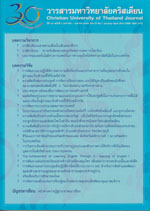ความสัมพันธ์ระหว่างกล้ามเนื้อทรานสเวอร์ซุส แอ็บโดมินิส กับแนวกระดูกสันหลังส่วนเอว กระดูกเชิงกรานและข้อสะโพกในท่ายืน ของนักศึกษาหญิงมหาวิทยาลัยคริสเตียน
บทคัดย่อ
การวิจัยครั้งนี้มีวัตถุประสงค์ ศึกษาความสัมพันธ์ของกล้ามเนื้อทรานสเวอร์ซุส แอ็บโดมินิส และแนวกระดูกสันหลังส่วนเอว กระดูกเชิงกรานและข้อสะโพกในท่ายืน ในนักศึกษาหญิงมหาวิทยาลัยคริสเตียน ที่มีอายุตั้งแต่ 18 - 25 ปี จำนวน 94 คน ที่มีกำลังกล้ามเนื้อเรคตัส แอ็บโดมินิส, เอกซ์เทอร์นัล แอ็บโดมินัล อ็อบลิค, อินเทอร์นัล แอ็บโดมินัล อ็อบลิคปกติ และความยาวกล้ามเนื้อโซแอสปกติ โดยทดสอบกำลังกล้ามเนื้อทรานสเวอร์ซุส แอ็บโดมินิส ตามวิธีของซานนอททิ วัดและคำนวณความโค้งของกระดูกสันหลังส่วนเอวตามวิธีของโลเวลล์ มุมของกระดูกเชิงกรานตามวิธีของแซนเดอร์ และมุมของข้อสะโพกในท่ายืน
ผลการวิจัยพบว่า กำลังกล้ามเนื้อทรานสเวอร์ซุส แอ็บโดมินิสมีความสัมพันธ์กับมุมกระดูกเชิงกรานอย่างมีนัยสำคัญทางสถิติระดับมาก (p < 0.001) (r = -0.834) กำลังกล้ามเนื้อ ทรานสเวอร์ซุส แอ็บโดมินิสมีความสัมพันธ์กับแนวโค้งกระดูกสันหลังส่วนเอวอย่างมีนัยสำคัญทางสถิติระดับมาก (p < 0.001) (r = -0.899) มุมข้อสะโพกมีความสัมพันธ์กับมุมกระดูกเชิงกรานอย่างมีนัยสำคัญทางสถิติระดับน้อย (p < 0.05) (r = 0.206) และยังพบว่ามุมกระดูกเชิงกรานมีความสัมพันธ์กับแนวโค้งกระดูกสันหลังส่วนเอวอย่างมีนัยสำคัญทางสถิติระดับมาก (p < 0.001) (r = 0.936) จากการศึกษาสรุปได้ว่า หากกล้ามเนื้อทรานสเวอร์ซุสแอ็บโดมินิสอ่อนแรงจะส่งผลให้แนวโค้งกระดูกสันหลังส่วนเอวเพิ่มขึ้น และกระดูกเชิงกรานจะหมุนไปทางด้านหน้ามากขึ้น ดังนั้นหากพบผู้ป่วยมีแนวโค้งกระดูกสันหลังส่วนเอว และกระดูกเชิงกรานที่ผิดปกติ ควรพิจารณาการออกกำลังกายเพื่อเพิ่มความแข็งแรงกล้ามเนื้อ ทรานสเวอร์ซุส แอ็บโดมินิสเพื่อแก้ไขปัญหาดังกล่าว
เอกสารอ้างอิง
ปราณีต เพ็ญศรี. (2542). Low back pain (LBP) : An update management model. วารสารสหเวชศาสตร์. 3(1) : 57-73.
Akuthota, V., and Nadler, F. (2004). Core strengthening. Archives of physical medicine and Rehabilitation. 85 : 86-92.
Alviso, DJ., Dong, GT., and Lentell, GL. (1988). Intratester Reliability of Measuring Pelvic Tilt in Standing. Physical Therapy. 68(9) : 1374-1351.
Dontigny, RL., Gajdosik, R., Simpson, R., and Smith, R. (1985). Pelvic Tilt : Intratester Reliability of Measuring the Standing Position and Range of Motion. Physical Therapy. 65(2) : 169-174.
Hides, J., Mendis, MD., Sexton, M., and Stanton, W. (2011). The Relationship of Transversus Abdominis and Lumbar Multifidus Clinical Muscle Test in Patients with Chronic Low Back Pain. Manual Therapy. 16 : 573-577.
Hislop, HJ., and Montgomery, J. (1995). Muscle Testing : Techniques of Manual Examination. 6th edition. United State of America : Barbara Connelly.
Hodges, PW. (1999). Is there a Role for Transversus Abdominis in Lumbo-Pelvic Stability. Manual Therapy. 4(2) : 74-86.
Hodges, PW., and Richardson, CA. (1996). Inefficient muscular stabilization of the lumbar spine associated with low back pain. A motor control evaluation of transversus abdominis. Spine. 21 : 2640-2650.
Fredericson, M., and Moore, T. (2005). Muscular Balance, Core Stability, and Injury Prevention for Middle-and Long-Distance Runners. Physical Medicine and Rehabilitation Clinical of North America. (16) : 669-689.
Kisner, C. and Colby, LA. (2012). Therapeutic Exercise: Foundations and Techniques. 6th Edition. F. A. Davis Company : Philadelphia.
Link, CS., Nicholson, GG., Shaddeau, SA., Birch, R., & Gossman, MR. (1990). Lumbar curvature in standing and sitting in two types of chairs : relationship of hamstring and hip flexor muscle length. Physical Therapy. 70(10), 611-618.
Rajabi, R., Seidi, F., and Mohamadi, F. (2008). Which method is accurate when using the flexible ruler to measure the lumbar curvature angle? Deep point or midpoint of arch. World Applied Sciences Journal. 4(6) : 849-852.
Richardson, CA., Snijders, CJ., Hides, JA., Damen, L., Pas, MS., and Storm, J.(2002). The relation between the transversus abdominis muscles, sacroiliac joint mechanics, and low back pain. Spine. 27(4) : 399-405.
Sanders, G., and Stavrakas, P. (1981). A technique for measuring pelvic tilt. Physical Therapy. 61(1) : 49-50.
Visnic, S. (2008). 4 Essential Strategies for the Correction of Anterior Pelvic Tilt and Excessive Lumbar Lordosis. [Online]. Retrieved July 15, 2012, from https://www.End Your Back Pain Now.com
Walker, ML., Rothstein, JM., Finucane, SD., Lamb, RL. (1987). Relationships Between Lumbar Lordosis, Pelvic Tilt, and Abdominal Muscle Performance. Journal of the American Physical Therapy Association. (67) : 512-516.
Youdas, JW., Garrett, TR., Harmsen, S., Suman, VJ., and Carey, JR. (1996). Lumbar Lirdosis and Pelvic Inclination of Asymptomatic Adults. Journal of the American Physical Therapy Association. (76) : 1066-1081.
Youdas, JW., Garrett, TR., Egan, KS., and Therneau, TM. (2000). Lumbar lordosis and pelvic inclination in adults with chronic low back pain. Physical Therapy. 80(3) : 261-275.
Zannotti, CM., Bohannon, RW., Tiberio, D., Dewerry, MJ., and Murray, R. (2002). Kinematics of the double-leg-lowering test for abdominal muscle strength. The Journal of Orthopaedic and Sports Physical Therapy. 32(9) : 432-436.



